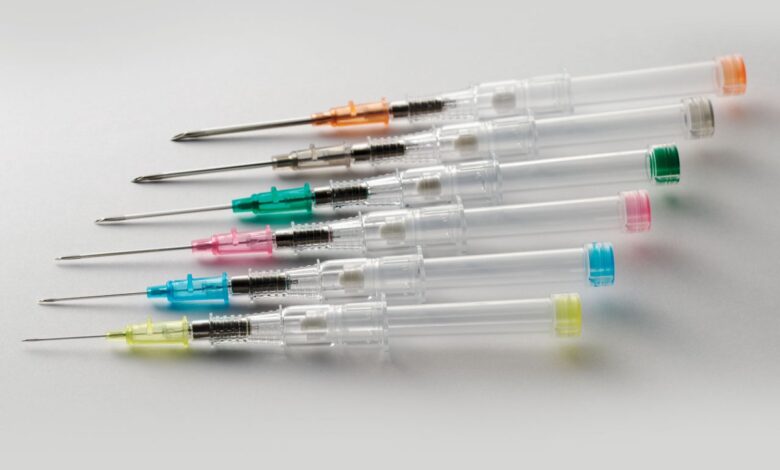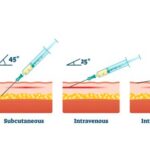What Gives Faster Effects, IM, IV, or Subcutaneous Injection?

Drug injection is a method of introducing a drug into the bloodstream via a hollow hypodermic needle, which is pierced through the skin into the body. Injections generally administer a medication as a bolus (or one-time) dose, but can also be used for continuous drug administration. After injection, a medication may be designed to be released slowly, called a depot injection, which can produce long-lasting effects.
If you’re living with a chronic condition, your doctor might prescribe injectable medication rather than medication taken by mouth. This allows medication to be absorbed directly into the bloodstream, which can make it more fast-acting than oral medication. Some injectable medications are formulated to release their active ingredients slowly over time rather than all at once.
What are the types of injection?
Injections can be given in several ways. How a medicine is injected depends on a variety of factors including:
• How the drug is made
• How quickly the medication takes effect
• How much liquid is in the injection
The three main types of injections include:
Subcutaneous: A subcutaneous injection is a method of administering medication. Subcutaneous means under the skin. In this type of injection, a short needle is used to inject a drug into the tissue layer between the skin and the muscle. Medication given this way is usually absorbed more slowly than if injected into a vein, sometimes over a period of 24 hours. This type of injection is used when other methods of administration might be less effective. For example, some medications can’t be given by mouth because acid and enzymes in the stomach would destroy them.
Intramuscular (deep into a muscle): an intramuscular injection is a technique used to deliver a medication deep into the muscles. This allows the medication to be absorbed into the bloodstream quickly. You may have received an intramuscular injection at a doctor’s office the last time you got a vaccine, like the flu shot. In some cases, a person may also self-administer an intramuscular injection. For example, certain drugs that treat multiple sclerosis or rheumatoid arthritis may require self-injection.
Intravenous (through a vein): Some medications must be given by an intravenous (IV) injection or infusion. This means they’re sent directly into your vein using a needle or tube. In fact, the term “intravenous” means “into the vein.” With IV administration, a thin plastic tube called an IV catheter is inserted into your vein. The catheter allows your healthcare professional to give you multiple safe doses of medication without needing to poke you with a needle each time.
What Gives Faster Effects, IM, IV, or Subcutaneous Injection?
Medication given subcutaneously is usually absorbed more slowly than if injected into a vein, sometimes over a period of 24 hours. IV drug administration achieves high plasma concentrations rapidly in plasma and tissues. Muscles are very vascular structures, and IM absorption occurs by drug diffusion from interstitial fluid and capillary membranes into plasma, and so onset of action is longer than IV injection.
However, in some cases Intramuscular injections may be used instead of intravenous injections because some drugs are irritating to veins, or because a suitable vein can’t be located.
Safe injection practices
Safe injection practices are intended to prevent transmission of infectious diseases from one patient to another, or between a patient and health care personnel during preparation and injection of medications. Health care personnel most frequently handle parenteral medications when administering local anesthesia, during which needles and anesthetic cartridges are used for one patient only, and the dental cartridge syringe is cleaned and heat-sterilized between patients.
Other safe practices apply to use of injected medications in IV fluids, such as for patients undergoing conscious sedation. A safe injection does not harm the recipient and does not expose health care personnel to any avoidable risks.
Centers for Disease Control and Prevention’s (CDC’s) safe injection practice recommendations are:
- Prepare injections using aseptic technique in a clean area.
- Disinfect the rubber septum on a medication vial with alcohol before piercing.
- Do not use needles or syringes for more than one patient (this includes manufactured prefilled syringes and other devices such as insulin pens).
- Medication containers (single and multidose vials, ampules, and bags) are entered with a new needle and new syringe, even when withdrawing additional doses for the same patient.
- Use single-dose vials for parenteral medications when possible.
- Do not use single-dose (single-use) medication vials, ampules, and bags or bottles of intravenous solution for more than one patient.
- Do not combine the leftover contents of single-use vials for later use.
- The following apply if multidose vials are used:
- Dedicate multidose vials to a single patient whenever possible.
- If multidose vials will be used for more than one patient, they should be restricted to a centralized medication area and should not enter the immediate patient treatment area (e.g., dental operatory) to prevent inadvertent contamination.
- If a multidose vial enters the immediate patient treatment area, it should be dedicated for single-patient use and discarded immediately after use.
- Date multidose vials when first opened and discard within 28 days, unless the manufacturer specifies a different date.
- Do not use fluid infusion or administration sets (e.g., IV bags, tubings, connections) for more than one patient.
You May Also Find Useful information on: What to do If You Find a Used Syringe





